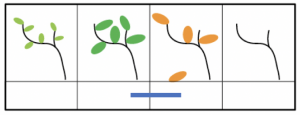Rudbeckia laciniata
Cutleaf Coneflower
Asteraceae
Sunflower Family

Cutleaf Coneflower is a common summertime sight on the Highlands Plateau, its brilliant yellow daisy-like flowers bringing splashes of color to roadsides and wood margins. The genus name Rudbeckia, which includes Black-eyed Susans, was chosen by Linnaeus to honor his mentors Olof Rudbeck the younger (1660-1740) and Olof Rudbeck the elder (1630-1702), both botanists at Uppsala University. The species name laciniata, Latin for “jagged” or “cut,” is a reference to the deeply cut and sharp-lobed leaves.
While the flowers of this species understandably get all the attention, it’s well worth inspecting the leaves too. If you’re lucky you might find one or more spiny black caterpillars of the Silvery Checkerspot butterfly,
(Family Nymphalidae, the Brush-Footed Butterflies), contentedly chewing away. If you’re even luckier, you might find a little treehopper family hidden on the underside of a leaf. In our area two species in particular,
(the Two-Marked Treehopper, with two yellow spots on its back) and
(the Notched Treehopper), lay their eggs in a cluster in the midrib of Cutleaf Coneflower leaves. This causes the leaf to droop at the point where the eggs are inserted, forming a snug canopy over the little treehopper family. You can often find both treehopper parents with their young in early summer, and you might even spot ants in the mix. These are friends, not foes: like aphids, treehoppers secrete sweet droplets of honeydew as they feed on plant sap. Ants, knowing a good thing when they find it, aggressively protect the treehoppers from predators so that they can tend them, like little insectan cows, for the sugary honeydew. `

Recent Comments